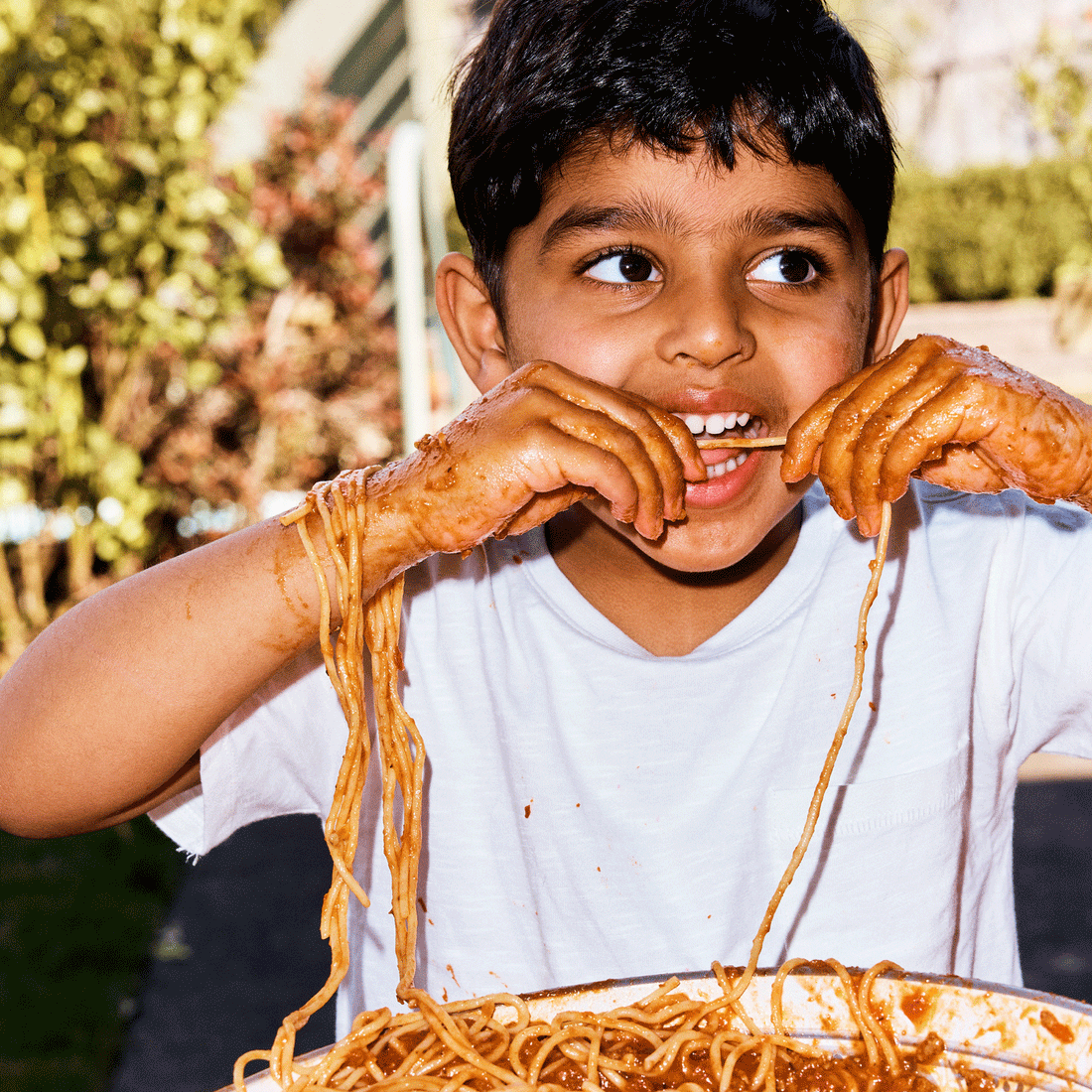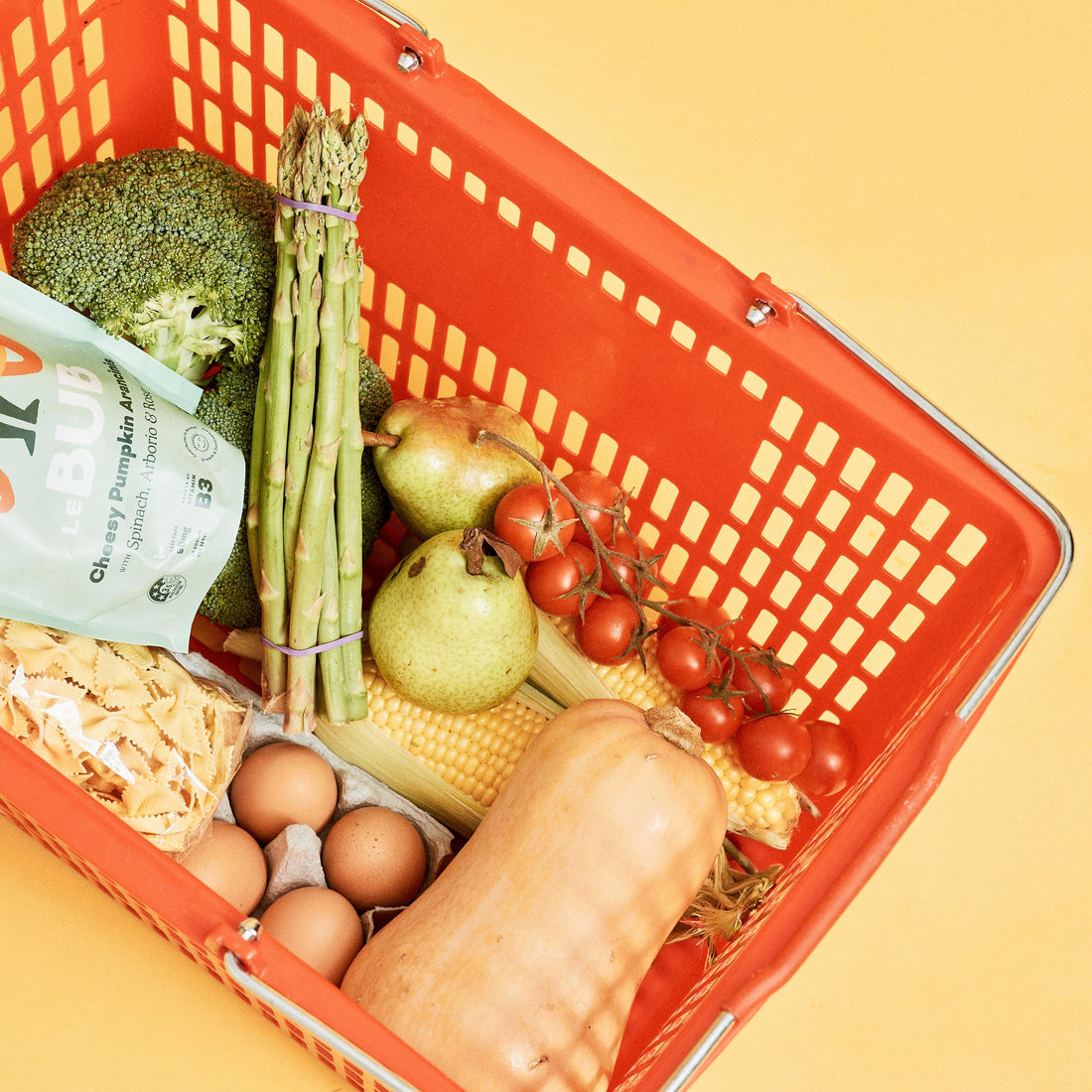Or as close as you can get with a three-year-old.
When my son turned three, he became a Picky Eater™. Where I had once regularly fed him yoghurt sprinkled with spirulina and turmeric chia pudding (I know, yuck), he now insisted on nothing but bland. Plain Weetbix with milk, peanut butter and banana toast and naked spaghetti were all good, anything not brown, beige or yellow was not. I wasn’t sure what had caused him to transform – seemingly overnight – into a pint-sized food critic (in hindsight, maybe the spirulina yoghurt, lol), but I began to worry about his eating.
At first, I tried to out will him. When he didn’t like what I’d made for dinner, I refused to offer a second meal no matter how much he complained and cried. It’s not that I felt he was playing me for a better option, I knew he was genuinely struggling with what I was asking him to do: force down food he didn’t want to eat. A lot of the advice I received at this time revolved around standing my ground until he caved. This didn’t gel with my general approach to parenting, but I had no clue what else I could do to improve things. I felt like I needed to choose between a) bribing him, b) threatening punishment or c) sending him to bed hungry.
I know I’m not alone in having navigated a fussy preschooler. There are forums galore dedicated to picky eating, and they’re overflowing with comments from stressed parents looking for solidarity and solutions. When your kids are in this phase – and for most of them, it is just a phase – you worry sick about their nutrition and development. (I once googled, ‘how many bananas is safe for a preschooler?’) You kvetch about what to make for dinner that won’t result in wasted food. It can be a very isolating and confusing experience.
From how to start solids to tips and tricks you can use to encourage them to eat, there’s a lot of info out there on feeding babies. Preschoolers? Not so much. So first: what do healthy eating habits for preschoolers actually look like? Normal eating behaviour for little kids is a spectrum. Just like us, they’ll sometimes want to put away a lot of food but may only feel like grazing on other days. As a general rule, most kids can only handle being seated for two to five minutes per year of age. That means that a three-year-old can only reasonably sit at the table for six to fifteen minutes before they’ll feel compelled to get up. Just being aware of what is developmentally appropriate can help you to manage your expectations and frustrations around mealtimes.
Research shows that keeping your cool as a parent around food is important because it can shape their eating behaviours and food preferences. Finding ways to encourage healthy eating without infusing mealtimes with stress and anxiety is key. One thing that helped me a lot was thinking about the picky eating from my son’s point of view – preschoolers have such little control over their lives, but they can decide what they put into their mouths. That ‘aha moment’ allowed me to understand why we were experiencing such power struggles.
With that in mind, and without further ado, here are the picky eating tips that worked for us.
1. We reframed his likes and dislikes
You may have heard that it can take 10-12 tastes of a single food to know whether you like it or not, so this tip is actually rooted in science. Whenever my son would say he didn’t like [insert food here], we’d say, ‘That’s OK! You haven’t learned how to like it yet. Good on you for giving it another go.’ It was revolutionary.
He came to believe that he would eventually learn how to like all foods, so he was happy to keep tasting them. The key here was to avoid placing pressure on him – it wouldn’t have worked otherwise. When we’d ask him to try a food and he declined, that was it. There was no nagging or begging or bargaining. When he did try a new food, we’d stand by with a napkin ready in case he wanted to spit it out. Often he did. But then we’d get magic moments of genuine enjoyment, like the time he tried his dad’s pasta and exclaimed, ‘Mum! I learned how to like mushrooms!’ When this happened, we’d make a HUGE deal about it, and he’d beam with pride.
2. We introduced a ‘no thank you’ bowl
If your kid can’t handle foods they dislike even being present on their plate, you’re going to thank me for this one. With every meal, we began to give my son an extra, empty ‘no thank you’ bowl, instructing him to place anything on his plate that he didn’t want to eat inside it. There was no longer any need to cry and carry on at meals – if he didn’t like something he’d been served, he simply transferred it into the bowl. We made no commentary on it at all, so he felt safe to eat as much or little as he liked. Over time, the food placed in the bowl got less and less until he didn’t really require one anymore. He’s now five and will sometimes still ask for a ‘no thank you bowl’, but it’s infrequent. Like a lot of these tips, the reason it worked so well is that it made him feel more in control. We also used it in restaurants which helped to prevent cute public meltdowns.
3. We stopped saying ‘you won’t like that’
This one was especially challenging for me because I grew up being cajoled into eating everything on my plate. I was so averse to food ‘waste’ that I found myself telling other people in charge of feeding him (educators, grandparents) what he would and wouldn’t eat. At some stage, I had the realisation that by telling others ‘he won’t eat that’ I was reinforcing his likes and dislikes and preventing them from ever changing.
Instead of perceiving trying and rejecting foods as being a ‘waste’, I began to accept it as key to the process of expanding his palate. If we were at a friend’s house for lunch, we let our son be served something even if we thought he would reject it. (Even if it was the twentieth time he’d screwed up his face and yelled, “YUCK, I HATE IT’.) Sometimes he ate it, sometimes he didn’t. (The times he didn’t, it got added to a parent’s plate or the dog’s bowl.) Peer influence is a funny thing – my kid ate things with friends that he wouldn’t do at home.
4. We ensured there was something on his plate he’d eat
This one is pretty self-explanatory. With every meal, we’d make sure that there were enough ‘safe’ foods on his plate to satisfy his hunger. That way if the new foods were rejected, we were comfortable that he had eaten enough. (If you’re stuck in a rhythm of preparing secondary meals, this trick can be particularly helpful.)
For us, it also worked to dial down the ‘I don’t like it’ outbursts because my son could see familiar things on his plate. Whether it was a handful of cherry tomatoes, a roasted potato, diced fruit or nut butter on rice crackers, we would always choose something nutritious. As he learned to like more foods, we’d cycle them.
On this, you can also try to add their favourite foods to things they otherwise don’t like/won’t try. My kid was obsessed with chicken schnitzel. (Aren’t we all?) One day, he saw me eating a salad that had chopped-up chicken schnitzel mixed through it and wanted to try. That was the day he learned how to like rocket.
5. We ate a lot of ‘assemble it yourself’ meals
I can’t remember where I came across this advice, but in the depths of my son’s pickiness, it saved me. Preparing meals your family can put together themselves at the table (think: burgers, tacos, rice paper rolls, flatbread wraps) allows your child choice over what goes in their meal. We still set the example we want our son to follow (so, adding lettuce to our savoury crepes even if we don’t love it) but we don’t wig out if he doesn’t copy us. The goal is to create an atmosphere of low-stakes experimentation where they feel in control.
6. We learned how to use a sectioned plate
Here’s a thing: serving foods in separate compartments on a divided plate can tell kids’ brains that those foods shouldn’t touch. One way to get around this is to modify the plate by mixing foods in each compartment. When serving my son meals on a divided plate (we also used the regular kind), I was aware of mixing fruits and veggies instead of placing them in separate compartments. I’d chuck chopped banana and blueberries together, and then make a tiny chopped salad of tomatoes and cucumbers. I’d sometimes stack meat and cheese on crackers, so he was constantly seeing foods mixed together, instead of totally separated.
If your kid gets upset when their food is touching, this can be tricky to navigate. Children with sensory issues in particular may struggle with food unless it’s served in separate compartments. If this is the case for you, it can help to position the different foods a little closer together in the main compartment of a divided plate.
7. We experimented with dinner table games
Experts agree that shared family mealtimes are important for modelling healthy eating habits and strengthening connections. It’s not always possible for us to do this (my husband works odd hours) but when we are together, we prioritise it. Dinnertime is consistently chaotic, so we keep it simple by asking playful questions (‘If you could be any animal, what would you be?’, ‘What superpower would you love to have?’). Conversation starters like High Low Buffalo are really useful on days we don’t have the brain power to summon any creativity. We each share a High and Low from our day, and then a Buffalo – a random tidbit we found amusing. If he wants to be quiet, my son has a special colouring mat and textas he can use at the table.




















